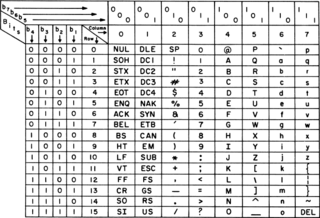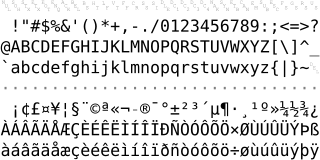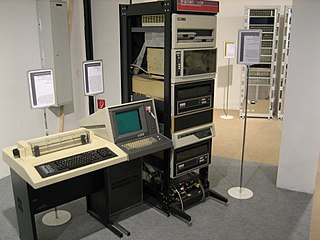Related Research Articles

ASCII, an acronym for American Standard Code for Information Interchange, is a character encoding standard for electronic communication. ASCII codes represent text in computers, telecommunications equipment, and other devices. ASCII has just 128 code points, of which only 95 are printable characters, which severely limit its scope. The set of available punctuation had significant impact on the syntax of computer languages and text markup. ASCII hugely influenced the design of character sets used by modern computers, including Unicode which has over a million code points, but the first 128 of these are the same as ASCII.

In computing, a printer is a peripheral machine which makes a durable representation of graphics or text, usually on paper. While most output is human-readable, bar code printers are an example of an expanded use for printers. Different types of printers include 3D printers, inkjet printers, laser printers, and thermal printers.
Extended Binary Coded Decimal Interchange Code is an eight-bit character encoding used mainly on IBM mainframe and IBM midrange computer operating systems. It descended from the code used with punched cards and the corresponding six-bit binary-coded decimal code used with most of IBM's computer peripherals of the late 1950s and early 1960s. It is supported by various non-IBM platforms, such as Fujitsu-Siemens' BS2000/OSD, OS-IV, MSP, and MSP-EX, the SDS Sigma series, Unisys VS/9, Unisys MCP and ICL VME.

ISO/IEC 8859-1:1998, Information technology — 8-bit single-byte coded graphic character sets — Part 1: Latin alphabet No. 1, is part of the ISO/IEC 8859 series of ASCII-based standard character encodings, first edition published in 1987. ISO/IEC 8859-1 encodes what it refers to as "Latin alphabet no. 1", consisting of 191 characters from the Latin script. This character-encoding scheme is used throughout the Americas, Western Europe, Oceania, and much of Africa. It is the basis for some popular 8-bit character sets and the first two blocks of characters in Unicode.

Dot matrix printing, sometimes called impact matrix printing, is a computer printing process in which ink is applied to a surface using a relatively low-resolution dot matrix for layout. Dot matrix printers are a type of impact printer that prints using a fixed number of pins or wires and typically use a print head that moves back and forth or in an up-and-down motion on the page and prints by impact, striking an ink-soaked cloth ribbon against the paper. They were also known as serial dot matrix printers. Unlike typewriters or line printers that use a similar print mechanism, a dot matrix printer can print arbitrary patterns and not just specific characters.

The VT100 is a video terminal, introduced in August 1978 by Digital Equipment Corporation (DEC). It was one of the first terminals to support ANSI escape codes for cursor control and other tasks, and added a number of extended codes for special features like controlling the status lights on the keyboard. This led to rapid uptake of the ANSI standard, which became the de facto standard for hardware video terminals and later terminal emulators.
ISO/IEC 646 is a set of ISO/IEC standards, described as Information technology — ISO 7-bit coded character set for information interchange and developed in cooperation with ASCII at least since 1964. Since its first edition in 1967 it has specified a 7-bit character code from which several national standards are derived.
In computing, a code page is a character encoding and as such it is a specific association of a set of printable characters and control characters with unique numbers. Typically each number represents the binary value in a single byte.
The Multinational Character Set is a character encoding created in 1983 by Digital Equipment Corporation (DEC) for use in the popular VT220 terminal. It was an 8-bit extension of ASCII that added accented characters, currency symbols, and other character glyphs missing from 7-bit ASCII. It is only one of the code pages implemented for the VT220 National Replacement Character Set (NRCS). MCS is registered as IBM code page/CCSID 1100 since 1992. Depending on associated sorting Oracle calls it WE8DEC, N8DEC, DK8DEC, S8DEC, or SF8DEC.
The Kamenický encoding, named for the brothers Jiří and Marian Kamenický, was a code page for personal computers running DOS, very popular in Czechoslovakia around 1985–1995. Another name for this encoding is KEYBCS2, the name of the terminate-and-stay-resident utility which implemented the matching keyboard driver. It was also named KAMENICKY.
The C0 and C1 control code or control character sets define control codes for use in text by computer systems that use ASCII and derivatives of ASCII. The codes represent additional information about the text, such as the position of a cursor, an instruction to start a new line, or a message that the text has been received.
ASMO 449 is a, now technologically obsolete, 7-bit coded character set to encode the Arabic language.
The National Replacement Character Set (NRCS) was a feature supported by later models of Digital's (DEC) computer terminal systems, starting with the VT200 series in 1983. NRCS allowed individual characters from one character set to be replaced by one from another set, allowing the construction of different character sets on the fly. It was used to customize the character set to different local languages, without having to change the terminal's ROM for different countries, or alternately, include many different sets in a larger ROM. Many 3rd party terminals and terminal emulators supporting VT200 codes also supported NRCS.

Extended ASCII is a repertoire of character encodings that include the original 96 ASCII character set, plus up to 128 additional characters. There is no formal definition of "extended ASCII", and even use of the term is sometimes criticized, because it can be mistakenly interpreted to mean that the American National Standards Institute (ANSI) had updated its ANSI X3.4-1986 standard to include more characters, or that the term identifies a single unambiguous encoding, neither of which is the case.
In computing HP Roman is a family of character sets consisting of HP Roman Extension, HP Roman-8, HP Roman-9 and several variants. Originally introduced by Hewlett-Packard around 1978, revisions and adaptations were published several times up to 1999. The 1985 revisions were later standardized as IBM codepages 1050 and 1051. Supporting many European languages, the character sets were used by various HP workstations, terminals, calculators as well as many printers, also from third-parties.

The DECwriter series was a family of computer terminals from Digital Equipment Corporation (DEC). They were typically used in a fashion similar to a teletype, with a computer output being printed to paper and the user inputting information on the keyboard. In contrast to teletypes, the DECwriters were based on dot matrix printer technology, one of the first examples of such a system to be introduced. Versions lacking a keyboard were also available for use as computer printers, which eventually became the only models as smart terminals became the main way to interact with mainframes and minicomputers in the 1980s.
The Israeli Standards Institute's Standard SI 960 defines a 7–bit Hebrew code page. It is derived from, but does not conform to, ISO/IEC 646; more specifically, it follows ASCII except for the lowercase letters and backtick (`), which are replaced by the naturally ordered Hebrew alphabet. It is also known as DEC Hebrew (7–bit), because DEC standardized this character set before it became an international standard. Kermit named it hebrew–7 and HEBREW–7.
In computing, a hardware code page (HWCP) refers to a code page supported natively by a hardware device such as a display adapter or printer. The glyphs to present the characters are stored in the alphanumeric character generator's resident read-only memory and are thus not user-changeable. They are available for use by the system without having to load any font definitions into the device first. Startup messages issued by a PC's System BIOS or displayed by an operating system before initializing its own code page switching logic and font management and before switching to graphics mode are displayed in a computer's default hardware code page.
The RPL character set is an 8-bit character set and encoding used by most RPL calculators manufactured by Hewlett-Packard as well as by the HP 82240B thermo printer. It is sometimes referred to simply as "ECMA-94" in documentation, although it is for the most part a superset of ISO/IEC 8859-1 / ECMA-94 in terms of printable characters, and it differs from ISO/IEC 8859-1 by using displayable characters rather than control characters in the 0x80 to 0x9F range of code points.
Code page 1102, also known as CP1102 or NL7DEC, is an IBM code page number assigned to the Dutch variant of DEC's National Replacement Character Set (NRCS). The 7-bit character set was introduced for DEC's computer terminal systems, starting with the VT200 series in 1983, but is also used by IBM for their DEC emulation. It is called DUTCH by Kermit.
References
- 1 2 3 "ELOT 927 7-Bit Greek Character Set". Kermit . Columbia University . Retrieved 2020-04-29.
- 1 2 3 Flohr, Guido (2016) [2002]. "Locale::RecodeData::GREEK7 - Conversion routines for GREEK7". CPAN libintl-perl. 1.0. Archived from the original on 2017-07-16. Retrieved 2017-07-16.
- ↑ Digital Equipment Corporation (DEC). "7. Character Sets". VT510 Video Terminal Programmer Information . Retrieved 2017-02-18.
- ↑ "Data Sheet FUJITSU Dot Matrix Printer DL 3850+" (PDF) (Product Flyer). Fujitsu. Archived (PDF) from the original on 2017-07-16. Retrieved 2017-07-16.
- ↑ "DL6400 Pro / DL6600 Pro - 24 Wire Dot Matrix Printers" (PDF) (Product flyer). Fujitsu. Archived (PDF) from the original on 2017-07-16. Retrieved 2017-07-16.
- ↑ Fujitsu DL7600 User's Manual - 24-wire dot matrix printer. Fujitsu. p. E-22. Retrieved 2017-07-16.
- 1 2 "Character Sets Reference Manual for Line Matrix Printers" (PDF). Printronix. 1998. p. 61. P/N 164308–001, Rev B. Retrieved 2017-07-16.
- ↑ User's Manual - The Printronix P7000 Series PSA3 Printer. Printronix, Inc. 2005 [1997]. p. 264.
- ↑ "4". Printronix P8000 Series Cartridge Ribbon Printer - Administrator's Manual: Serial Matrix Character Set Menu. Printronix, Inc. 2013. p. 158.
- ↑ "Character sets". Kermit . Columbia University. 2000-01-01. Archived from the original on 2017-02-15. Retrieved 2017-02-15.
- ↑ "ELOT 927 Mapping Table". 2017. Archived from the original on 2017-07-16. Retrieved 2017-07-16.